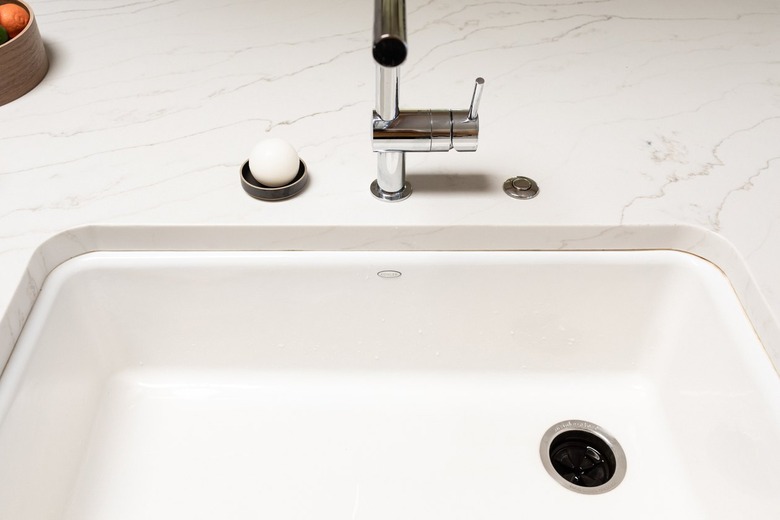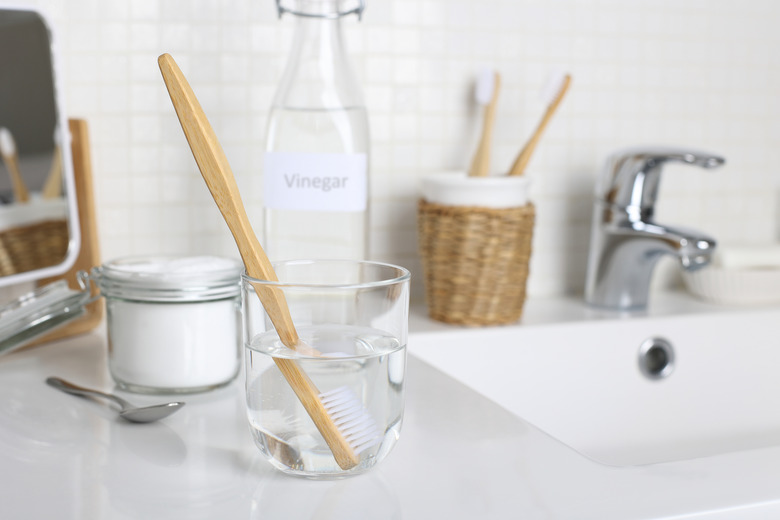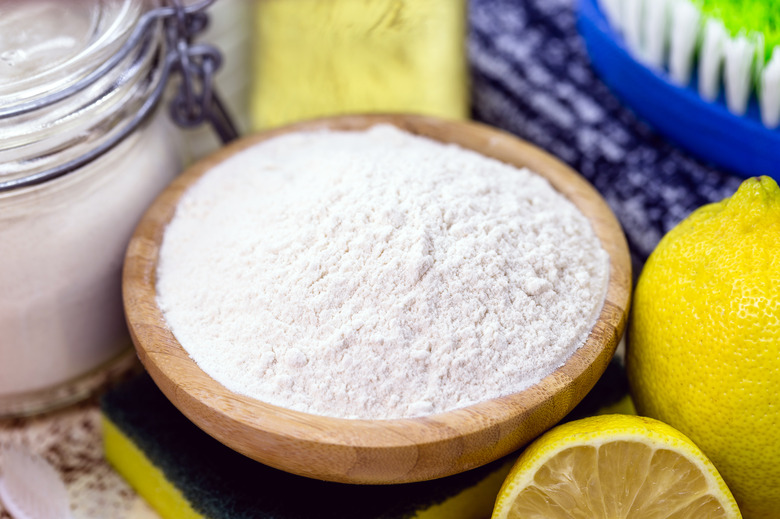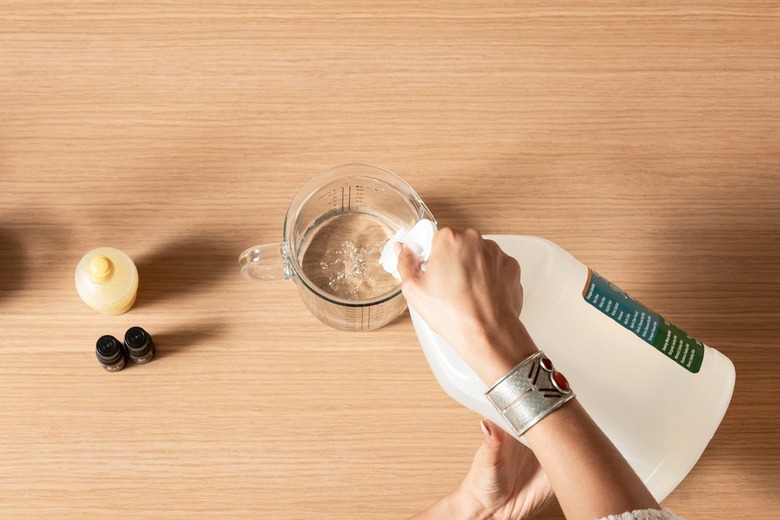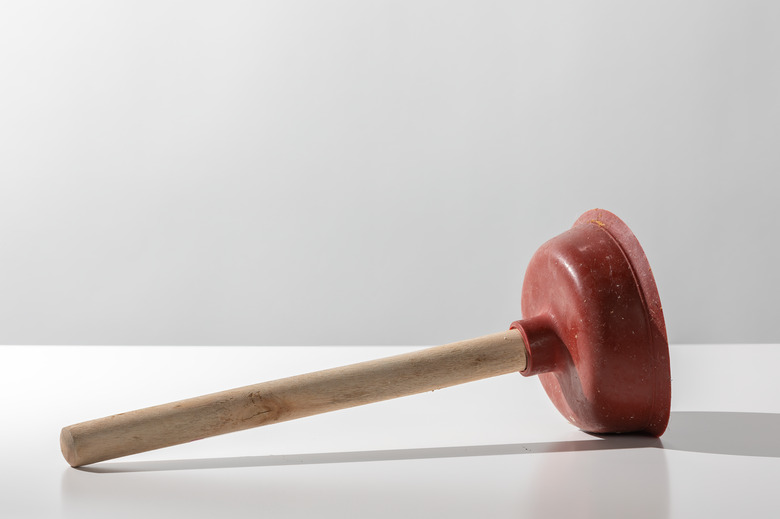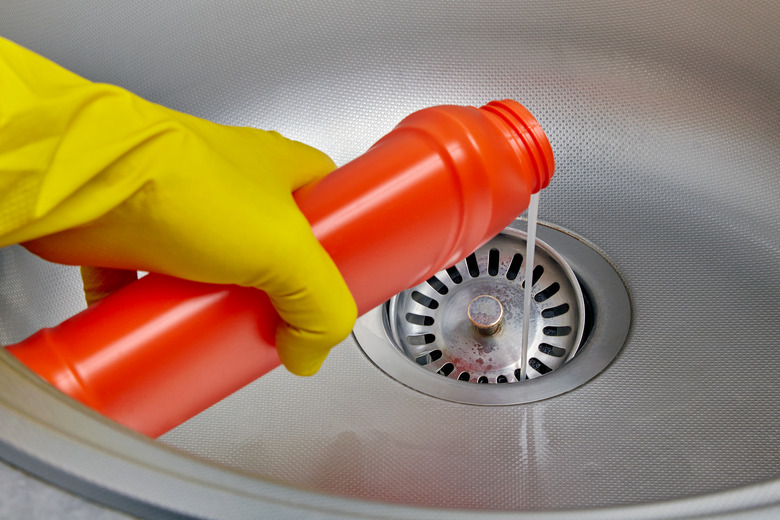Do DIY Drain Cleaners Actually Work? Here's What The Science Says
We may receive a commission on purchases made from links.
Once you understand the potential hazards of using commercial caustic or acidic drain cleaners to clear a clogged drain, you may scour the internet for safer DIY alternatives. Baking soda is the solution you'll see most often. Some people suggest mixing it with boiling water, others recommend salt, and still others tell you to mix it with vinegar, cream of tartar, or hydrogen peroxide. Other DIY drain cleaners use bleach or some combination of vinegar, lemon juice, dish soap, salt, borax, hydrogen peroxide, and hot tap water. Some DIYers also recommend washing soda, which is similar to baking soda but stronger. You can even find plumbing sites advising that cola can clear drains.
So, do DIY drain cleaners actually work? Here's what the science says.
Comparing Different DIY Drain Cleaners
Comparing Different DIY Drain Cleaners
DIY drain cleaners do work, but some work better than others (and they probably don't work as well as commercial drain cleaners do). Reach for a DIY cleaner if you have a partial drain clog — a more severe clog warrants the use of something a little stronger. Before you turn your drain into a microcosm of your cupboards and refrigerator, it helps to heed what science has to say about the efficacy of specific DIY drain cleaners.
DIY Drain Cleaners
|
Worst |
Better |
Best |
|
Baking soda alone |
Baking soda + hydrogen peroxide |
Vinegar + lemon juice |
|
Baking soda + vinegar |
Salt |
Dish soap |
|
Baking soda + lemon juice |
Borax |
Plunger |
|
Baking soda + cream of tartar |
Cola |
Auger |
|
Disassembled P-trap |
DIY Drain Cleaner: Baking Soda
DIY Drain Cleaner: Baking Soda
Chemists call baking soda sodium bicarbonate, and its chemical formula is NaHCO3. When dissolved in water, it forms a mildly alkaline solution with a pH between 8 and 9 depending on the concentration. A neutral solution (neither alkaline nor acidic) has a pH of 7, so compared to sodium hydroxide (NaOH), which can have a pH as high as 13 in high concentrations, sodium bicarbonate isn't very alkaline and therefore not very caustic. You can pour a baking soda solution on your hand and hardly notice it, but you'll burn your skin if you do that with a sodium hydroxide solution.
When you clean your drain with baking soda, your drain will smell fresher, but baking soda is unlikely to eat its way through blockages all by itself, which is why people combine it with other ingredients in the hopes of making it more effective. Some work better than others.
Baking Soda and Vinegar
Vinegar is an acetic acid solution (CH3COOH), and at the concentration used in the kitchen, it has a pH of around 2.4, making it a reasonably strong acid. Baking soda is a base, and when you mix an acid and a base, they neutralize each other and produce a salt. The chemical equation for the reaction between vinegar and baking soda is NaHCO3+ CH3COOH →NaC2H3O2 + H2O + CO2. In this reaction, the salt is sodium acetate (NaC2H3O2), and carbon dioxide (CO2) is released as a byproduct.
By mixing baking soda and vinegar, you lose their caustic and acidic properties in exchange for carbon dioxide, which may create an impressive foaming volcano but is fairly ineffective as a drain cleaner. The fizz may dislodge particles from the pipes, though, especially if you close the drain stopper to allow the foam to create a downward force. Be sure to pour baking soda and vinegar into the drain separately (baking soda first); if you mix them outside the drain, they'll react before they can do any good. Following the vinegar with dish soap may increase the cleaning potential of the fizz.
Baking Soda and Lemon Juice
Like baking soda, lemon juice is acidic. It contains citric acid, which has a pH in the same range as acetic acid, and mixing it with baking soda produces the same results: a salt and a bunch of CO2 foam but this time with a fresh lemon scent. The combination is a weak drain cleaner, but it's great for cleaning and deodorizing a garbage disposal.
Baking Soda and Hydrogen Peroxide
The reaction between sodium bicarbonate and hydrogen peroxide also produces carbon dioxide foam, but the other byproduct, sodium peroxide, is more useful for cleaning. It can dissolve hard water deposits and some types of grease. This combination works best when you add boiling water, but even so, it's unlikely to dissolve tough clogs.
Baking Soda and Cream of Tartar
A mixture of equal parts of cream of tartar and baking soda is known as baking powder. Because it releases carbon dioxide gas when mixed with water, it's used for leavening bread. It will have an effect on your drain similar to a mixture of baking soda and vinegar but probably not as pronounced. Use it with boiling water to give it a boost.
DIY Drain Cleaners Without Baking Soda
DIY Drain Cleaners Without Baking Soda
A DIY drain cleaner is one that utilizes common household ingredients, and there are more than a few possibilities.
Vinegar and Lemon Juice
Because they are acidic, vinegar and lemon juice may be even more effective by themselves for drain cleaning than they are mixed with baking soda. The trick is to use them in high concentrations (try using cleaning vinegar, a nonedible vinegar with a high concentration of acetic acid) and leave them in contact with the clog for as long as possible. If you have a stopped drain, suck out all the water with a wet/dry vacuum because both acids are weaker when mixed with water. Pour in at least a cup of vinegar (regular white vinegar or apple cider vinegar) or a cup or more of lemon juice — enough to see the top level of the liquid in your drain — and wait for the level to begin falling.
Dish Soap
Soap works by bonding with the fat molecules in grease clogs and basically lifting them off the surface to which they are clinging. Adding dish soap to any drain cleaning concoction will make it more effective, and it can also lift clogs all by itself, especially when you pour boiling water into the drain after pouring in the soap.
Salt
Salt doesn't undergo any useful drain cleaning reactions. but it does provide abrasive cleaning action, so if you're going to add salt to a homemade drain cleaner, make it coarse kosher salt. A cup of salt can be especially useful in conjunction with a fizzy concoction because it adds muscle to the fizz and will help a slow drain clear faster. Salt corrodes metal, though, so don't use too much of it or let it stand in the drain too long if you have metal pipes.
Borax
Borax is another nonreactive drain cleaning ingredient that is basically abrasive, but it's noncorrosive, so it's safer for metal pipes than salt. Because borax doesn't react, it's a better addition to vinegar or lemon juice than baking soda if you want to take advantage of their acidic qualities. Add boiling water to fortify the mixture and clean your sink drain that much faster.
Cola
Yes ... cola. As long as it's tangy, it contains phosphoric acid (check the label to be sure), and if tangy cola can dissolve nails (which it can), it can clean your sink or shower drain. The trick is to keep it undiluted and in direct contact with the clog for as long as possible, so it probably won't help a drain that isn't completely blocked. If you have a stopped drain, clear out the water with a vacuum, fill the drain with cola, and wait. After the drain clears, flush it with hot water to remove sticky sugar residue.
Bleach
Bleach is a sodium hypochlorite solution, and in the concentration found in household bleach, it has a pH between 11 and 13, which is significantly more alkaline and corrosive than baking soda. It isn't something you want to use in your kitchen sink because it will stain stainless steel, but it can clear clogs in bathtub and shower drains (as long as the drain fittings are not stainless steel). If you opt for bleach, don't mix it with anything else because of the danger of a reaction that might release chlorine gas.
Mechanical DIY Drain Cleaning Methods
Mechanical DIY Drain Cleaning Methods
A DIY drain cleaner usually works if you give it enough time, but if you're serious about removing blockages fast, mechanical drain cleaning methods are better.
Plunger
Almost every plumber agrees: A plunger is the go-to tool for clearing a clogged drain. It works best when the drain is full of water and there's about an inch of water in the sink. If you don't have success after the first few pumps, cover the overflow hole in the sink with duct tape to focus the plunging action on the clog. An open overflow hole lets air into the drain and breaks the suction you need for optimal plunging.
Auger
When DIY drain cleaners and plungers don't work, it's time for the heavy artillery in the form of an auger, also known as a drain snake. One disadvantage of this tool is that it won't fit into your drain if there's a nonremovable strainer or cross bar. However, if you can get the head of the auger cable into the drain, simply push until you hit the buildup causing the clog. Crank the handle and the head will work its way through any soap scum or food waste that might be there.
Disassembled P-Trap
After trying all these drain cleaning methods, it's unlikely that your clog won't clear, but if that's what happens, put a bucket under the sink to catch water and take the P-trap apart. You might find that someone put paint, plaster, or something else into the drain. With the trap removed, you'll be better able to clean it as well as the pipe sections on either end of the trap, and you'll have better access to the rest of the drain for your auger. With the trap removed and the waste opening exposed, you can also try to suck out the clog with a wet/dry vacuum.
How Commercial Drain Cleaners Work
How Commercial Drain Cleaners Work
Every commercial drain cleaner is one of three types: caustic, acidic, or enzymatic. Drano, one of the best-known commercial drain cleaners, is caustic; its active ingredient is sodium hydroxide (lye) that works by basically corroding and dissolving gunk that causes clogs. The chemical has three potentially hazardous side effects: It can corrode pipes, it creates heat that can melt pipes, and it can burn the skin of any plumber who does a follow-up drain cleaning if it doesn't work.
Sulfuric acid, another common active ingredient in harsh commercial drain cleaners, is a stronger chemical that works by dissolving gunk, but it's even more hazardous than sodium hydroxide and has more potential for damaging the pipes and burning skin. Most products containing it should be used only in emergency situations and preferably by a licensed plumber.
Enzymatic drain cleaners, like Green Gobbler, are the safest commercial products. They promote the organic decomposition of drain clogs, but this is a process that takes time. They usually don't provide instant relief from a major clog, but given enough time (several hours to a day), they get the job done.
